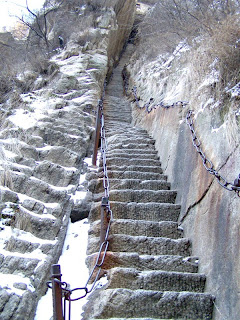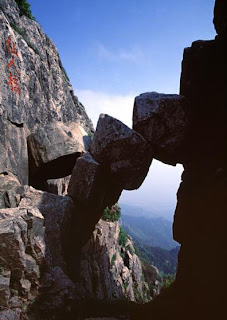Heng Shan in Shanxi province is one of the Five Sacred Mountains of Taoism. At 2,017 m, it is one of the five tallest peaks in China Proper. Heng Shan in Shanxi province is sometimes known as the Northern Heng Shan, and should not be confused with the Southern Heng Shan in Hunan Province. Both mountains have the same pronunciation in Chinese, and the Southern Heng Shan is also one of the Five Sacred Mountains.
Hanging Monastery stands at the foot of Mt. Hengshan, 5 kilometers (3 miles) south ofHunyuan County, and 65 kilometers (40 miles) from downtown Datong City. Since it hangs on the west cliff of Jinxia Gorge more than 50 meters above the ground, it is called Hanging Monastery.
Hanging Monastery, built in 491, has survived more than 1,400 years. The extant monastery was largely rebuilt and maintained in the Ming Dynasty (1368-1644) and Qing Dynasty (1644-1911). The buildings were restored in 1900 and there are 40 wooden halls and structures linked by an ingenious system of pillars, posts and walkways.
How could a building like this withstand the winds and storms of so many years? Hanging Monastery is an architectural wonder. A unique mechanical theory was applied to building the framework. Crossbeams were half-inserted into the rock as the foundation, while the rock in back became its support. Seen from below, Hanging Monastery appears to be a tumble-down castle in the air. Inside, Hanging Monastery provides the same scene as other temples.
Construction experts from countries including Britain, Germany, and Italy, come to see the monastery. In their words, Hanging Monastery, which mixes mechanics, aesthetics, and Buddhism, is rare. The monastery and everything it symbolizes embodies a great cultural achievement of Chinese people.
The second attraction of Hanging Monastery is that it includes Buddhism, Taoism and Confucianism. Inside the monastery, the sculptures of Sakyamuni, Confucius and Laotzu appear together, which is unusual. There are 40 halls and cabinets, which contain about 80 sculptures made of copper, iron, terracotta, and stone. The features are vividly carved.
Why build a monastery like this? Location is the first reason; building a monastery on the cliff could shield it from floods. In addition, the mountain peak protects it from rain and snow; and the mountain around it also diminishes damage from long-time sunshine. The second reason is that the builders followed a principle in Taoism: no noises, including those from rooster crowing and dog baying; so from the upper ground, all noises drop away.
Other Great Mountain:
Friday, April 25, 2008
Categories:
China Scenery.
Author: Smith
Mount Heng, known in China as Nan Yue is located in Hunan and is one of the Five Sacred Mountains of Taoism in China. Heng Shan is a mountain range 150 km long with 72 peaks and it is located in Hunan Province .
Other Great Mountain:
Thursday, April 24, 2008
Categories:
China Scenery.
Author: Smith
Mount Song, known in Chinese as Song Shan, is one of the Taoist Five Sacred Mountains and is located in Henan province on the south bank of the Yellow River in China. Its summit is 1,500 meters above sea level. The nearby Shaolin Temple is the birthplace of Zen Buddhism, and even today the temple's collection of stupas is the largest in China.
Wednesday, April 23, 2008
Categories:
China Scenery.
Author: Smith
Mount Hua is one of the "Five Sacred Mountains" of China. Mount Hua is located in the Shanxi Province, about 100 kilometres east of the city of Xi'an, near the city Huayin. The mountain has five peaks. It is famous for its natural vistas of steep and narrow paths, precipitous crags, and a high mountain range. It is home to several influential Taoist temples where emperors of past dynasties made pilgrimages, making Mt. Huashan the holy land of Taoism.
Usually tourists climb up the mountain assisted by the iron chains along the way and start their tour from Yuquan Yuan (Jade Spring Temple), one of the main Taoist temples in China located at the foot of Mt. Huashan. The path up the south peak is rumored to be the most dangerous hiking trail on earth, because it partly consists of thin wooden planks mounted on a cliff with chains to hold on.
Friday, April 18, 2008
Categories:
China Scenery.
Author: Smith
Mount Tai, the first of the "Five Sacred Mountains", is located in the central part of Shandong Province. It lies in the civilized land of the ancient states of Qi and Lu, with the Yellow River on the north and the sea on the east. A famous saying goes, "Scaling Taishan Mountain makes one feel superior to the whole world", as it creates a feeling of regal dignity and imperial majesty.
Historical records show that a total of 72 emperors of bygone dynasties, from the first Qin Emperor Shihuang onward, have made sacrifices to Taishan Mountain. This association with feudalism has earned the mountain a widespread fame. Nowadays, after repeated renovations, Mt Tai has become more enchanting than ever before. Mount Tai has been a UNESCO World Heritage Site since 1987. In 2003, it attracted around 6 million visitors.
In total, there are 22 temples, 97 ruins, 819 stone tablets, and 1,018 cliff-side and stone inscriptions located on Mount Tai. A flight of 7,200 total steps (including inner temple steps), with 6,293 Official Mountain Walkway Steps, lead up the East Peak of Mount Tai, along its course, there are 11 gates, 14 archways, 14 kiosks, and 4 pavilions.
Thursday, April 17, 2008
Categories:
China Scenery.
Author: Smith


























































